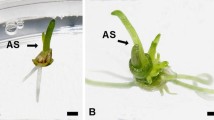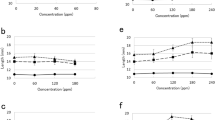Abstract
In the pea test a highly positive response to the treatment with IAA reversed to a negative one or became 5 to 6 times weaker when CCC was applied together with IAA. In cultivating pea seedlings, following their decapitation, for two days in a 0.25 per cent CCC solution and then in water, growth of their cotyledonous axillaries (cotylaries) were inhibited. This inhibitive action of CCC could be made ineffective when the seedlings, following two-days’ cultivation in the CCC solution, were grown further in kinetin solutions (0.37–3 mg per 1). Cotylaries of decapitated pea seedlings, when grown in kinetin solutions were inhibited. With kinetin solutions of 6–12 mg/l a strong inhibition also occured in the growth of roots at the apical parts of which spherical swellings were developing.
The CCC supplied to the roots of intact etiolated pea seedlings is translocated acropetally into the stem at a rate of about 5 cm per hour. Decapitation of the plant causes retardation of this transport, yet a coat of 0.00001–1% IAA or kinetin paste produces acceleration of the stream.
Existence of an antagonism between CCC and IAA, demonstrated earlier, was found holding true also for B-9 (N, N-dimethyl-aminesuccinamic acid) and IAA, as the inhibitive action of B-9, 0.06% solution on the growth of lettuce hypocotyls was reduced to a highly significant degree when the plants were supplied with B-9 together with IAA at a concentration of 10 mg/l.
Abstract
Vysoce pozitivní reakce na indolyloctovou kyselinu (IAA) v hrachovém testu byla zvrácena v negativní nebo 5–6násobně zeslabena, byl-li spolu s IAA aplikován i chlorcholinchlorid (CCC).
Byly-li klíční rostliny hrachu po dekapitaci kultivovány 2 dny v 0,25% roztoku CCC a pak ve vodě, byl značně inhibován růst děložních axilárů (kotylárů) proti kontrolám kultivovaným po celou pokusnou dobu ve vodě. Tento inhibiční vliv CCC však bylo možno zrušit, byly-li rostliny po dvoudenní kultivaci v roztoku CCC pěstovány v roztocích kinetinu (0,37–3 mg/l). Byly-li však dekapitované rostliny hrachu od počátku pěstovány v těchto roztocích kinetinu, pak byl proti kontrolám kultivovaným ve vodě růst kotylárů inhibován a při pěstování v roztocích kinetinu 6–12 mg/l byl silně inhibován i růst kořenů na jejichž apikálních částech se vytvářely kulovité nádorky.
CCC dodaný kořenům intaktních etiolovaných klíčních rostlin hrachu je akropetálně transportován do lodyhy rychlostí asi 5 cm za hod. Dekapitací rostlin se tento proud zeslabí, ale nátěrem 0,00001–1% IAA pasty na řeznou plochu po dekapitovaném epikotylu se urychlí úměrně koncentraci užité pasty, při čemž 0,003–0,0007% IAA pasta působí na transport stejně jako ponechaný vrchol. Byla-li na řeznou plochu po dekapitovaném vrcholu natřena 0,00001–1% pasta n kinetinem, byl tím rovněž transport urychlen proti kontrolám, v nichž byla na řeznou plochu natřena vodní past,a avšak nikoliv přímo úměrně koncentraci u|^zité pasty s kinetinem: pasty 0,1–0,01% velmi nápadně zesilovaly transport CCC, naproti tomu vlivem silnějších a slabších koncentrací se projevil již podstatný pokles stimulace akropetálního transportu CCC.
Antagonismus dokázaný již dříve mezi CCC a IAA platí i pro retardans B-9 a IAA, nebot inhibiční vliv 0,06% roztoku B-9 na růst hypokotylů salátu byl vysoce průkazně snížen, byla-li spolu s B-9 rostlinám dodána i IAA v koncentraci 10 mg/l.
Similar content being viewed by others
References
Halevy, A. H.: Interaction of growth-retarding compounds and gibberellin on IAA oxidase and peroxidase of Cucumber seedlings.—Plant Physiol.38: 731–737, 1963.
Knypl, J. S.: Action of (2-chloroethyl)trimethalammonium chloride, 2,4-dichlorobenzyl-tributylphosphonium chloride, and N-dimenthylamino-succinamic acid on IAA and coumarin induced growth of sunflower hypocotyl sections.—Acta Soc. Bot. Pol.35: 611–625, 1966.
Knypl, J. S.: Synergistic inhibition of kale seed germination by coumarin and CCC, and its reversal by kinetin and gibberellic acid.—Planta72: 292–296, 1967.
Lábler, L., Schwarz, V.: Chromatografie na tenké vrstvě. [Thin Layer Chromatography.]— ČSAV Praha, 1965.
Larter, E. N., Samii, M., Sosulski, F. W.: The morphological and physiological effects of (2-chloroethy)) trimethylammonium chloride on barley.—Can. J. Plant Sci.45: 419–427, 1965.
Mašková, J.: Studie o telemorfickém působení hormonálních herbicidů v klíčních rostlinách hrachu. [On the telemorphic effect of the hormonal herbicides in pea seedlings.]—Sborník VŠZ Brno C46: 1–48, 1949.
Norris, R. F.: Effect of (2-chloroethyl)trimethylammonium chloride on the level of endogenous indole compounds in wheat seedlings.—Can. J. Bot.44: 675–684, 1966.
Plaut, Z., Halevy, A. H.: Increasing the regeneration of wheat plants following wilting by treatment with two growth-retarding chemicals.—Naturwissenschaften19: 509, 1966.
Reed, D. J., Moore, T. C., Anderson, J. D.: Plant growth retardant B-995: A possible mode of action.—Science148: 1469–1471, 1965.
Šebánek, J.: Effect of the amputation of the cotyledon and of the application of growth regulators on the transport of32P in decapitated pea seedlings.—Biol. Plant.7: 380–386, 1965.
Šebánek, J.: Interaktion von Chlorcholinchlorid und exogenem Gibberellin in den Wachstumskorrelationen bei Keimpflanzen vonPisum sativum.—Flora A,156: 573–589, 1966.
Šebánek, J.: Die Verlängerung des ersten Internodiums und die Aszidienbildung bei Leinkeimlingen als ein morphogenetischer Beweis des Antagonismus zwischen CCC und endogenem Auxin.—Flora A158: 271–276, 1967a.
Šebánek, J.: Einfluss von Pasten mit verschiedenen Indolylessigsäure-Konzentrationen auf den Transport von32P in dekapitierten Erbsenepikotylen.—Planta75: 283–285, 1967b.
Šebánek, J.: Interakce růstových retardantů a giberelinu v korelacích u lnu, hrachu a rajčat. [Interaction of growth retardants and gibberellin in correlations of flax, peas and tomatoes.] Rostlinná Výroba13: 855–876, 1967c.
Šebánek, J.: The antagonism of (2-chlorethyl)trimethylammonium chloride and indole 3-acetic acid in epicotyl and axillary bud growth in pea seedlings.—Biol. Plant.10: 449–454, 1968.
Author information
Authors and Affiliations
Additional information
Address: Tolstého 16, Jihlava, Czechoslovakia.
Rights and permissions
About this article
Cite this article
Šebánek, J., Hradilík, J. On the interaction of growth retardants with IAA and kinetin. Biol Plant 11, 356–365 (1969). https://doi.org/10.1007/BF02921400
Received:
Issue Date:
DOI: https://doi.org/10.1007/BF02921400




